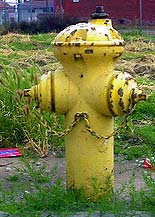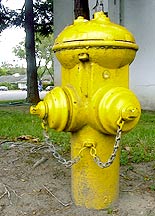
| ||
|
Stockton Fire Hydrants |
| Photos and Text by Willis Lamm |
|
Stockton, CA, incorporated in 1850, is one of only five cities that can
boast a city-wide overall ISO Class-1 fire protection rating. This is a
daunting feat considering all that goes on in this city.
CITY OVERVIEW Stockton is the business center of California's San Joaquin Valley, one of the richest agricultural regions in the world. The city process and distributes agricultural products and has a great deal of industry geared to agriculture including bulk storage and transportation of agrochemicals. It is a major rail center and has an active deep water port on the San Joaquin River which has the capacity to service 70% of the world's maritime fleet.
The city is home to a population of 248,000 citizens and two
universities; the University of the Pacific and California State
University Stanislaus. It hosts the San Francisco 49ers training camp.
It has a commercial airport, is the county seat and is the site of the
county fairgrounds. Stockton was awarded "All America City" in 1999.
The fire department consists of 229 uniformed personnel and 29 civilians
working out of 12 fire stations. Municipal water supply is provided by
California Water Service. Fire hydrants are maintained by the fire
department from two designated hydrant repair/maintenance vehicles. The
fire department protects the City as well as contracts to provide
coverage for some small adjacent districts and unincorporated "islands"
that exist within the city limits.
|
|
At the turn of the century Stockton established a design standard for
all fire hydrants. They were to be dry barrel type with two 4 inch
outlets. The first hydrants of this type were Rensselaer List 90s.
|
Rensselaer List 90
|
Around 1910 Stockton Iron Works started producing hydrants for the city. The earlier hydrants were single valve design with two 4" outlets. |
Stockton Iron Works
|
|
In the 1920s the Fire Department tried a 3-valve design. Stockton Iron
Works provided the first 3-valve hydrants which had two 4" outlets which
were set on 8" taps and risers.
|
Stockton Iron Works 3 valve |
In the 1930s Rensselaer was again awarded contracts for fire hydrants and provided their 3-valve double 4" version of their List-90 hydrant. |
Rensselaer 3 valve |
Continue to Part 2Jump to Part 3 | |||
|
|



